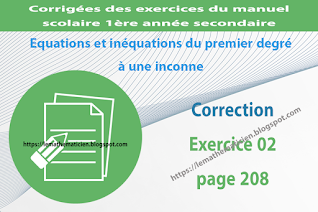Correction - Exercice 02 page 208 - Equations et inéquations du premier degré à une inconnue
Résoudre dans \(\mathbb{R}\) les équations suivantes :
a) \((2x + 3)^2 – (2x + 3) = 0\) :
\((2x+3)^2-(2x+3)=0\) \(\Rightarrow\)
\((2x+3)(2x+3)-(2x+3)=0\) \(\Rightarrow\)
\((2x+3)(2x+3-1)=0\) \(\Rightarrow\)
\((2x+3)(2x+2)=0\) \(\Rightarrow\)
\((2x+3)=0\) ou \((2x+2)=0\) \(\Rightarrow\)
\(x=-\frac{3}{2}\) ou \(x=-\frac{2}{2}=-1\).
\(S_\mathbb{R}=\{-\frac{3}{2};-1\}\).
b) \(9x^2 + 42x + 49 = 0\) :
il faut vérifier toujours si l'équation donnée peut se mettre sous la forme d'une identité remarquable.
\(9x^2 + 42x + 49 = 0\) \(\Rightarrow\)
\((3x)^2 + 42x + (7)^2 = 0\) \(\Rightarrow\) \((3x)^2 + 2.3x.7 + (7)^2 = 0\) elle est sous la forme de \((a^2+2.a.b+b^2=(a+b)^2)\) d'où :
\((3x+7)^2 = 0\) \(\Rightarrow\)
\(3x+7 = 0\) \(\Rightarrow\)
\(3x=-7\) \(\Rightarrow\)
\(x=-\frac{7}{3}\).
\(S_\mathbb{R}=\{-\frac{7}{3}\}\).
c) \((x + 1)^2 – (x + 1)(x –3) = 0\) :
\((x + 1)^2 – (x + 1)(x -3) = 0\) \(\Rightarrow\)
\((x + 1)(x + 1) – (x + 1)(x -3) = 0\) \(\Rightarrow\)
\((x + 1)[(x + 1)-(x -3)] = 0\) \(\Rightarrow\)
\((x + 1)(x + 1-x +3) = 0\) \(\Rightarrow\)
\((x + 1)(4) = 0\) \(\Rightarrow\)
\(x + 1 = 0\) \(\Rightarrow\)
\(x=-1\).
\(S_\mathbb{R}=\{-1\}\).
d) \((y + 3)(y – 1) + (y + 3)(2y + 1) = 0\) :
\((y + 3)(y - 1) + (y + 3)(2y + 1) = 0\) \(\Rightarrow\)
\((y + 3)[(y - 1) + (2y + 1)] = 0\) \(\Rightarrow\)
\((y + 3)(y - 1 + 2y + 1) = 0\) \(\Rightarrow\)
\((y + 3)(3y) = 0\) \(\Rightarrow\)
\(y + 3=0\) ou \(3y=0\) \(\Rightarrow\)
\(y=-3\) ou \(y=0\).
\(S_\mathbb{R}=\{-3;0\}\).
e) \(6(t – 2 ) + (t – 2)^2 = t (t – 2)\) :
\(6(t - 2 ) + (t - 2)^2 = t (t - 2)\) \(\Rightarrow\)
\(6(t - 2 ) + (t - 2)^2 - t (t - 2) = 0\) \(\Rightarrow\)
\((t - 2 ) (6 + (t - 2) - t ) = 0\) \(\Rightarrow\)
\((t - 2 ) (4) = 0\) \(\Rightarrow\)
\(t - 2=0\) \(\Rightarrow\)
\(t=2\).
\(S_\mathbb{R}=\{2\}\).
Libellés:
1ère année secondaire
Correction
Corrigées
Equations et inéquations du premier degré à une inconnue
exercice
Le Mathématicien
manuel scolaire
Math
Mathématiques



Aucun commentaire: